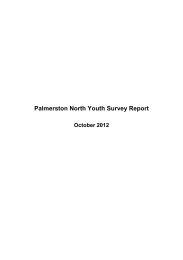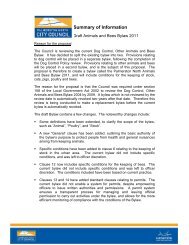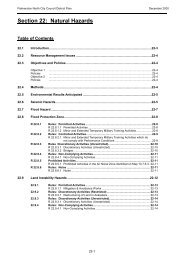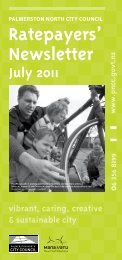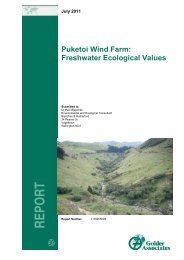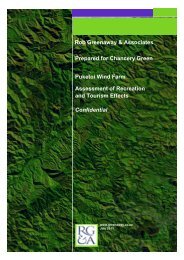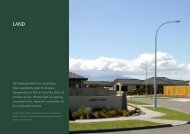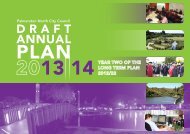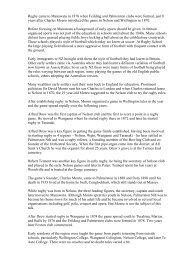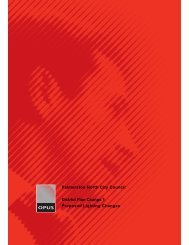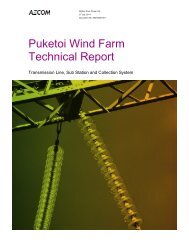Rural-Residential Land Use Strategy Discussion Document - May
Rural-Residential Land Use Strategy Discussion Document - May
Rural-Residential Land Use Strategy Discussion Document - May
Create successful ePaper yourself
Turn your PDF publications into a flip-book with our unique Google optimized e-Paper software.
Glossary<br />
Ancillary Buildings – Means a building not being part of the principal building, the use of which is<br />
incidental to that of another building or buildings on the site. In the case of a site on which no building<br />
has been erected, it is a building incidental to the use of the principal building permitted on the site.<br />
This includes a garage, carport, tool shed, playroom, recreation room, glasshouse, swimming pool, spa<br />
pool and sleepout.<br />
Cadastral pattern – A technical term associated with land survey and the subdivisions process and which<br />
also describes the size, location and layout of lots and general form of development which emerges<br />
through the process of land development.<br />
Density - A term that describes the intensity of building on a particular site or in a particular zone, as<br />
defined within the District Plan. For example, in the <strong>Rural</strong> Zone, the density of development is primarily<br />
controlled through the minimum lot size rule.<br />
Development capacity - The permitted number of household lots/dwellings that a site or an area is able<br />
to accommodate at current densities (intensity), as defined within the District Plan.<br />
Development criteria - Criteria used to assess the suitability of development, generally in terms of its<br />
effects on the environment, and compliance with objectives, policies and rules of the District Plan.<br />
Development pattern - The subdivisional and land use pattern (or activities) taking place in an area or<br />
location.<br />
Farmparks or ecoparks - A specifically designed farm (or forest park) within rural areas where the<br />
design of the allotments and dwelling sites are each individually located to ensure the least impact on<br />
the rural environment and rural landscape values.<br />
Fragmentation - In the context of rural landuse, fragmentation means the breaking up of contiguous<br />
rural land into disconnected or discontinous parcels. Fragmenation can be caused by land subdivision<br />
and subsequent development including, housing, roading, powerlines and planting.<br />
Greenfield - New urban development on land not previously built on that is usually, but not always rural<br />
land.<br />
High class soils / elite soils/versatile soils - Fertile soils that are capable of supporting a wide range of<br />
crops and other plants. Typically they are deep, loamy, have good drainage and are relatively flat.<br />
Household - Defined as one person usually living alone, or two or more people usually living together<br />
and sharing facilities in a private dwelling (e.g cooking facilities, bathroom and toilet facilities, and living<br />
areas).<br />
Infill subdivision or residential infill - Means the splitting of an existing section into two or more<br />
allotments (lots) usually for the purpose of building another dwelling(s).<br />
Intensification – Means subdivision, use and/or redevelopment of areas within developed urban areas,<br />
to promote a more consolidated or concentrated form of development.<br />
Intensive Farming – Means the production of plant and animal produce, where the predominant<br />
productive processes are carried out within buildings. It includes, but is not limited to, poultry farming<br />
(where more than 50 poultry are farmed), intensive feedlot farming, fitch farming, rabbit farming, and<br />
mushroom production. It does not include domestic pig farming, glasshouse horticulture or hydroponic<br />
growing of plants.<br />
<strong>Land</strong>bank - Specific blocks of land that are zoned for development. This term is often used in relation<br />
to growth forecasts and monitoring the uptake of residential and industrial zoned land.<br />
Lot and allotment - As per the definition of “Allotment” in Section 218(2) of the Resource Management<br />
Act, including: any parcel of land under the <strong>Land</strong> Transfer Act 1952 that is a continuous area and whose<br />
23



